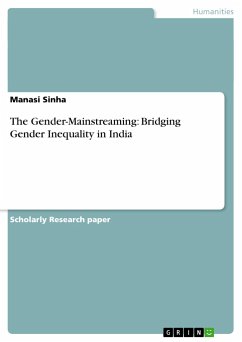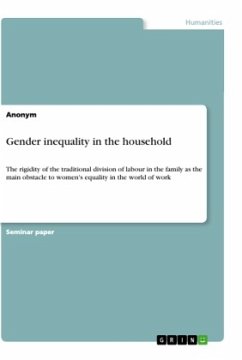
The Gender-Mainstreaming: Bridging Gender Inequality in India

PAYBACK Punkte
0 °P sammeln!
Research Paper (undergraduate) from the year 2013 in the subject Sociology - Gender Studies, Jawaharlal Nehru University (School of International Studies), course: Ph.D, language: English, abstract: The socially constructed gender roles which rooted in India's socio structural set upinternalizes further the sense of gender inequality or gender bias and accepted it as'Norm'. This gender inequality manifests across social, economic and political domainof Indian society in form of preference of boy child over a girl child, falling sex ratio,lack of participation of women in decision making proces...
Research Paper (undergraduate) from the year 2013 in the subject Sociology - Gender Studies, Jawaharlal Nehru University (School of International Studies), course: Ph.D, language: English, abstract: The socially constructed gender roles which rooted in India's socio structural set upinternalizes further the sense of gender inequality or gender bias and accepted it as'Norm'. This gender inequality manifests across social, economic and political domainof Indian society in form of preference of boy child over a girl child, falling sex ratio,lack of participation of women in decision making process, lack of control of womenover power structure in society. This further results in to domestic violence, sexualharassment, rape, molestation and may more crimes.There have been many gender equality measures taken place at policy level in order toreduce gender discrimination since independence. However, even after 65 years ofindependence India is still burning with gender discrimination at all levels. The reasonbehind this gender bias has been the fact that the gender equality measures are mostlyoriented towards women and sought to achieve gender equality through positive actionor economic opportunity for women only.This paper therefore, attempts to analyze the new gender equality measure namely thegender-mainstreaming strategy as a way to reduce this gender discrimination. Thepaper dwells into addressing three questions: How gender-mainstreaming strategycould be a better way to eliminate this gender bias? How is it different from othergender equality measures? and What results it could yield in the process of itsimplementation? Therefore the objective of the paper is to study how the sociallyconstructed gender roles result into gender discrimination in society and how thisdiscrimination can be removed through bringing changes in mindset of people andsociety at large with the help of gender-mainstreaming strategy.













